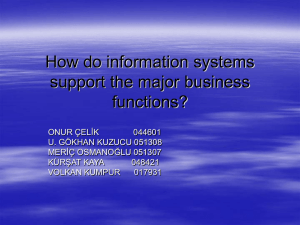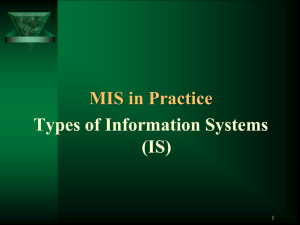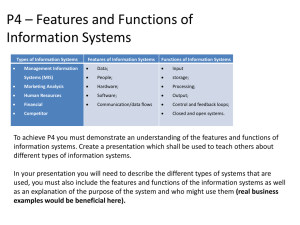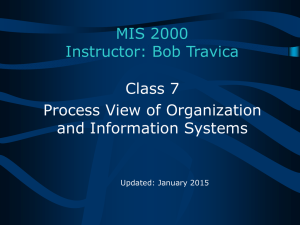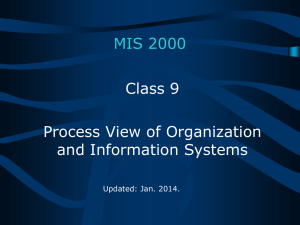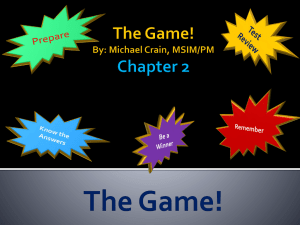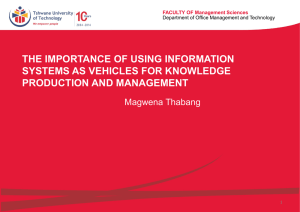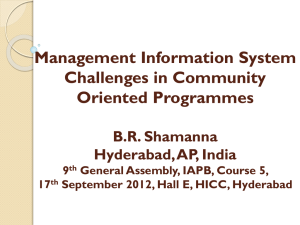Management Information Systems (MIS) Presentation
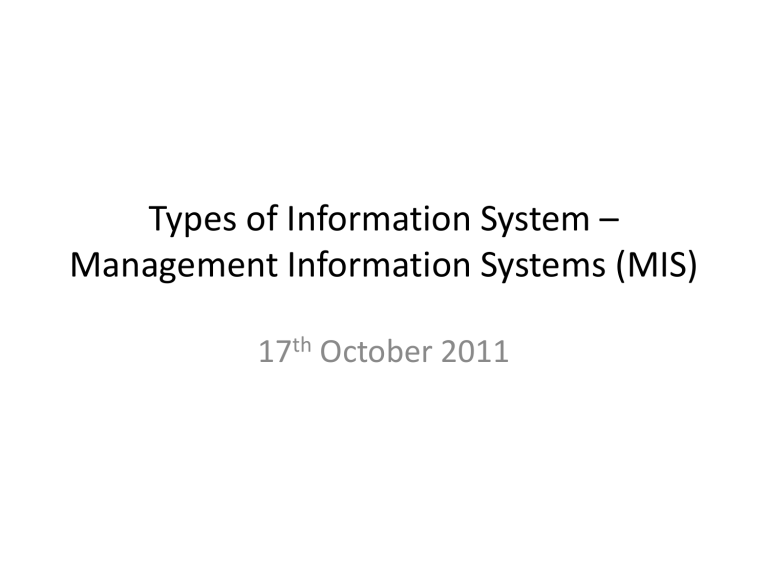
Types of Information System –
Management Information Systems (MIS)
17 th October 2011
Management Information System (MIS)
• MIS are a type of business information system that provide management-oriented reporting based on transaction processing and operations of the organisation (Bentley &
Whitten)
• Key points: “based on transaction processing and operations of the organisation”
– Why is this important?
Management Information System (MIS)
• MIS are used to support the management of organisational functions at the managerial level of the organisation
– The managerial level of a typical large organisation is the middle level whereby a focus is on the functional areas
– The management of functional areas require monitoring and controlling operational-level activities.
Different Levels of Organisation
Top Level –
Strategic
-----------------------------------------------
Middle Level –
Management
------------------------------------------------------
Lower Level –
Operations
• Middle level management require abstract information based on the data collected at the operational level.
• Transaction Processing
Systems (TPS) allow you to capture the data in the operational level
• The effectiveness of middle level management may often depend on the relevance and timeliness of the data collected in the
TPS.
Management Information System (MIS)
• In order to make management reports what information do you need?
• Think of a small shop – what information do managers need
• Think of a large supermarket – what information do managers need
Management Information System (MIS)
• Based on the information needs
– Where will they get this information?
– In a Small shop – what access to transactional data do they have?
– In a larger Supermarket – what access to transactional data do they have?
How Management Information Systems Obtain
Their Data from the Organization’s TPS
In the system illustrated by this diagram, three TPS supply summarized transaction data to the MIS reporting system at the end of the time period. Managers gain access to the organizational data through the MIS, which provides them with the appropriate reports.
Figure 2-3 8
E.G. Material Resource Planning
In the system illustrated by this diagram, three TPS supply summarized transaction data to the MIS reporting system at the end of the time period. Managers gain access to the organizational data through the MIS, which provides them with the appropriate reports.
Figure 2-3 9
E.G. Materials Resource Planning
– Taking the materials resource planning as an example
– Map out a typical MRP scenario
– E.g. To make product A
• Need 10 pieces of item #435 (Cost €0.20 per/item)
• Need 1 item #122 (Cost €3.50 per/item)
• Need 3 pieces of item #9adf6 (Cost €0.78 per/item)
– As a manager in the production team, what information do you need to do your job?
E.G. Materials Resource Planning
– As a manager in the production team, what information do you need to do your job?
– Managers often only require abstract information on sum key variables
• They are not interested in each individual transaction per se; rather instead they may be more interested in higher level information based on collections of transactions
• Dashboards of information are commonly used and allow managers to identify areas of concern quickly!
Example of Google Analytics
How Management Information Systems Obtain
Their Data from the Organization’s TPS
In the system illustrated by this diagram, three TPS supply summarized transaction data to the MIS reporting system at the end of the time period. Managers gain access to the organizational data through the MIS, which provides them with the appropriate reports.
Figure 2-3 13
